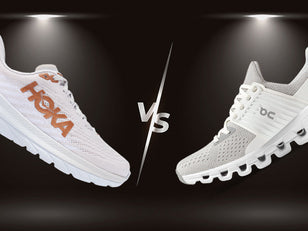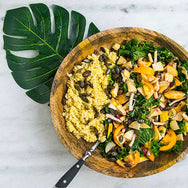By Linia Patel
You’re standing in the fruit and vegetable aisle of your local supermarket. You want to buy an apple. One hand you have an organic apple. On the other hand you have a “conventionally grown” apple. The conventional apple looks firm, shiny and green. The organic apple also looks firm, but is smaller, less shiny and more expensive. Which apple do you choose? If you really want to stay healthy, you may be inclined to choose the organic one right? But does an organic label mean that the food is actually more nutritious?

What qualifies as organic?
The word "organic" refers to the way farmers grow and process agricultural products, such as fruits, vegetables, grains, dairy products and meat. Organic farming practices are designed to be environmentally friendly. For example, farmers who grow organic produce don't use conventional methods to fertilize and control weeds. Organic livestock are fed organic feed without animal by-products and have access to outdoor pasture.
If you want to know if a food is organic or not you need to check the label. In the EU for foods to be labelled as organic, at least 95% of the ingredients must come from organically produced plants and animals. This means that the product must have been produced to these regulations and inspected and certified by a registered certification body.
Is organic food more nutritious?
Government agencies like the Food Standard Association (FSA) and the British Nutrition Foundation stand behind their claim that organic foods are not nutritionally superior to conventionally produced food. However in the last few years the research has evolved considerably. A recent systematic review suggests that this actually isn’t the case. The study published in the British Journal of Nutrition was the most extensive analysis (343 peer reviewed publications vs 46 publications reviewed by the FSA to substantiate their position statement) of the nutrient content in organic vs. conventionally produced foods ever done. It was led by Newcastle University and an international team of experts.
Key findings of the research were:
- Both organic milk ( dairy) and meat contain around 50% more beneficial omega-3 fatty acids than conventionally produced products
- Organic meat had slightly lower concentrations of two saturated fats that are linked to heart disease
- Organic milk and dairy contains 40% more conjugated linoleic acid (CLA) CLA is a type of fatty acid that is found naturally in milk. CLA exhibits potent antioxidant activity and some research indicates that CLA might be protective against heart disease, diabetes and cancer.
- Organic fruit and vegetables had on average 48% lower concentrations of the heavy metal cadmium. Excessive exposure to cadmium has been linked to toxic effects of the nervous and skeletal system.
- Conventional crops are four times more likely to have pesticide residue than organic ones. Nitrate concentrations were found to be significantly lower in organic crops. Diets high in nitrates have been linked to certain cancers.
- Switching to eating organic fruit and vegetables and cereals and food made from them would provide additional antioxidants equivalent to eating between 1-2 extra portions of fruit and vegetables a day

Interestingly, other recent studies have also shown that choosing organic foods can lead to increased intake of nutritionally desirable antioxidants and reduced exposure to heavy metals. A study published in the journal of Food Chemistry found that organic fruit and vegetables had a higher amount of antioxidants such as polyphenols (18 – 69%). Research shows that diets high in antioxidants lead to a reduced risk of chronic diseases, such as cardiovascular disease and certain cancers. Spanish researchers have also found that organically produced tomato juice contains higher lycopene levels (which contribute more antioxidant health benefits) than conventionally grown crops.
Despite the growing body of evidence that shows that there are nutritional differences between organic and conventional crops the government agencies are yet to change their position statements. The organic vs non-organic debate is likely to continue to rumble on until research that looks into the long-term health benefits of switching to organic food are done. However, for me personally there is now enough evidence to make me think about what goes on my shopping list.
Is it worth the cost?
There is no denying it but organic food is likely to come with a higher price tag. Higher prices are due, in part, to more-expensive farming practices. However, does the added cost mean that you need to skimp on healthy conventionally grown foods just because you can think you can save the pennies for the few organic items you can afford? Definitely not!
It’s about the bigger picture. If cost is an issue for you – then the best thing you can do for yourself is to eat a balanced and varied diet that includes a lot of vegetables and fruit. This will give you a better mix of nutrients and reduce your likelihood of exposure to a single pesticide. On the other hand if you can manage the higher price and like the idea of fewer pesticides/ insecticides and a more environmentally friendly production system then you might want to think about which foods you buy that are organic.

Good organic choices
If however, you like the idea of eating more nutrient dense foods that come with less pesticides and insecticides but aren’t ready to go completely organic then here are a few foods where you will get the most bang for your buck (i.e. foods with the highest pesticide/ insecticide load). These foods are:
High fat foods. Insecticides and pesticides are fat soluble so will accumulate to a higher level in foods that are high in fat. Going organic for these foods would reduce your pesticide load. High fat foods include:
- Meat, poultry, fish eggs. Animals that have been given access to outdoor pastures will have a better fatty acid composition in their meat and milk. They will have increased omega-3 for example, which helps lower the incidence of chronic diseases.
- Milk and dairy products. Conventional livestock feeding uses antibiotics and growth hormone to enhance growth of animals and fight disease. Use of these hormones has been linked to some cancers and the development of antibiotic resistance bacteria in people. Organic milk and dairy products come antibiotic and hormone free.
- Peanuts – peanuts are actually legumes and don’t have a hard shell like nuts to protect them from chemicals. Conventionally grown peanuts are treated with pesticides, with potential toxic effects, especially for kids.
TIP: Ultimately the nutritional benefits for meat/ poultry and dairy products comes from the fact that the animals are allowed to range free. Free-range doesn’t mean organic however! Make sure you read your label and know what you are buying.
Fruit and veggies. Conventional growers use synthetic pesticides to protect their crops from moulds, insects and diseases. When farmers spray pesticides, this can leave residue on fruit and veg. Organic farmers use insect traps, careful crop selection (disease-resistant varieties), predator insects or beneficial microorganisms instead to control crop-damaging pests. In general buying organic fruit and vegetables will limit your exposure to these residues however the following are the main residue carrying culprits:
- Strawberries have a large surface area and all those tiny bumps which makes pesticides hard to wash off. What’s more, conventionally grown strawberries sometimes appear a bit brighter in colour than their counterparts as some of them are enhanced with a substance containing a fungicide called captan.
- Fruits eaten with their skin (i.e. apples, peaches, cherries). The peel is where pesticides accumulate, so if you buy conventional fruit you can peel the fruit before you eat it, however you will be missing out on the fibre. Fibre is a nutrient we need to eat more of, so these fruits should be at the top of the organic foods priority list.
- Celery stalks are very porous so they retain the pesticides that are sprayed. Buying organic, minimises this.
- Spinach and kale as nutritious as they are lead the leafy green pesticide residue load. Buying organic means you get the nutrients minus the pesticides.
TIP: Think about investing in a vegetable box delivery scheme that provides organic produce and support your local farmer’s market and buy fruits and vegetables in season when possible.
Foods that you eat a lot of. Kids drink a lot of milk. As a nation we like our potatoes and bread. If you eat a lot of one particular food, you might want to think about minimising the pesticide load that comes with that one food. Common foods that are eaten in high volume that would be good organic options are:
- If you like your spuds going organic would be a smart choice as the average potato has more pesticide by weight than any other produce.
- If you are thinking of making your own then buy organic flour. If not – organic bread is a smart choice.
References:
- Barański M et al. 2014. Higher antioxidant and lower cadmium concentrations and lower incidence of pesticide residues in organically grown crops: a systematic literature review and meta-analyses. Br J Nutr. 2014 Sep 14;112(5):794-811. doi: 10.1017/S0007114514001366. Epub 2014 Jun 26.
- Dangour AD, Lock K, Hayter A, Aikenhead A, Allen E, Uauy R. 2010. Nutrition-related health effects of organic foods; a systematic review. Am J Clin Nutr. Jul;92(1)
- Crinnion WJ. Organic foods contain higher levels of certain nutrients, lower levels of pesticides, and may provide health benefits for the consumer. Altern Med Rev. 2010 Apr;15(1):4-12.





























































